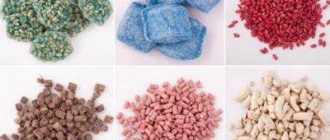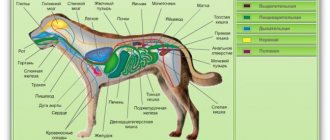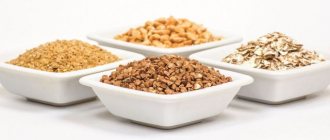Poisoning in dogs is not uncommon. Compared to other pets, they are indiscriminate in their food, and they have more opportunities to pick up poisonous bait. The result of intoxication may vary - from one-time vomiting to death. In case of severe poisoning, every minute counts, so the pet’s life depends on correctly provided first aid.
The owner of the animal must be able to notice signs of intoxication in time and know what to do if the dog is poisoned, especially when it is not possible to take the pet to the veterinarian and assistance must be provided at home.
How can a dog be poisoned?
In most cases, poison enters the animal’s body in three ways.
- The most common cause of dog poisoning is the dog eating poison. After this, toxins are absorbed from the stomach and intestines, the mucous membrane of the digestive tract is damaged, and the process of digesting food is disrupted.
- The dog inhales toxic fumes. In this case, toxins penetrate into the blood through the lungs, and the respiratory system suffers.
- The toxic substance is absorbed through the skin of the animal.
Once in the blood, toxins are distributed throughout the body. Depending on the type of poison, the heart and nervous system are affected. The liver and kidneys are always affected, as the main organs that neutralize the toxin.
The most common causes of poisoning in domestic dogs are as follows.
- Poor quality food. Typically, intoxication occurs as a result of picking up rotten meat or toxic substances from the ground. Sometimes the cause of food poisoning is spoiled ready-made dog food or leftover homemade food.
- Intentional poisoning by dog hunters. In such baits, isoniazid or rodent poisons are most often used.
- Incorrect use of veterinary drugs. This includes medications and remedies for parasites - worms, fleas, ticks. Poisoning can occur due to an overdose or an incorrectly selected drug. The dog licks off flea and tick medications that are incorrectly applied to the skin, resulting in poisoning.
- Human medicines from a home medicine cabinet. The animal may suffer as a result of the actions of its owners. Dogs have a different metabolism compared to humans. Harmless antipyretics from a home medicine cabinet can cause serious adverse reactions in them. Less commonly, accidental eating of pills left within reach is possible. Boric acid should not be used on dogs - it causes acute poisoning in the animal, which can be fatal.
- Poison for rats and mice. Currently, zoocoumarins are used to control rodents. This group of poisons causes blood clotting disorders, bleeding from natural orifices, and bruising on the skin. They have a cumulative effect. To poison a dog, you need a large dose or constant eating of baits, but it can become poisoned if it eats rodents that have died from the poison.
- Agricultural pesticides - insecticides, herbicides, fertilizers. They are used for treating seeds, wood, and spraying fields. Many are made with mercury or arsenic. Pesticides can contaminate soil and water if used, stored, and disposed of improperly.
- Household chemicals.
- Anti-ice reagents.
- Gasoline, kerosene, and paint vapors can poison a dog if it is indoors.
- Carbon monoxide.
- Petroleum products through the skin.
- Alcohol. Ethyl alcohol is a toxic compound for dogs. It should not be given to an animal in any form.
- Unsuitable products. These primarily include chewing gum and cheap sweets containing xylitol. You shouldn't give dogs chocolate. It contains the alkaloid theobromine, which is toxic to them. A bar weighing 100 grams can cause chocolate poisoning even in large breeds of dogs.
- Rarely, intoxication with poisonous herbs occurs, for example, with house plants - milkweed, dieffenbachia, rhododendron, daffodils, tulips, azalea.
Ready-made dog foods can also lead to poisoning if they were stored incorrectly or the manufacturer was unscrupulous in production controls. For example, dry foods may contain ergot alkaloids due to the use of contaminated grains. Dogs should not be given cat food, and when preparing their diet, age recommendations must be followed.
The main cause of poisoning in dogs is the inattention of owners during walks.
The first signs of poisoning
By nature, a dog is a scavenger. Therefore, he often suffers from eating stale food. The stomach juice of canine animals contains a large amount of hydrochloric acid, which allows it to digest stale meat. However, modern dogs are pampered, so their food instincts often fail them. Sour porridge or rotten meat picked up during a walk can cause disruption of the stomach and intestines. In puppies, the digestive tract is even more vulnerable.
The first signs of food poisoning in a dog are as follows:
- refusal to eat;
- lethargy;
- vomit;
- diarrhea.
Vomiting usually occurs once or twice until the stomach empties. Body temperature is usually within normal limits.
Mild food poisoning can be treated at home, but only if the owner knows exactly what poisoned the dog. It is necessary to carefully monitor all symptoms and their dynamics. If threatening signs appear, you should immediately contact a veterinarian.
Food poisoning can easily be confused with viral enteritis. Repeated vomiting of white foam, rapid increase in weakness, very loose stools are obvious symptoms of viral enteritis.
Possibly chronic food poisoning. In this case, the signs of intoxication will be erased - diarrhea alternating with constipation, deterioration of general condition, poor appetite.
If feeding is disrupted, dogs often develop protein poisoning. If the diet is too high in protein and lacks cereals and vegetables, then chronic intoxication occurs. Protein poisoning in a dog can be determined by the following signs:
- exhaustion;
- deterioration and hair loss;
- peeling of the skin, itching;
- diarrhea;
- changes in urine.
Protein poisoning develops over a month or more; signs of the onset of the disease increase gradually.
Food poisoning in a dog
Dogs are very curious creatures and try to test everything. They, unlike cats, are not as picky about food. Therefore, the owner’s task is to monitor the quality of his pet’s food. What can cause poisoning in a dog? Veterinary clinic specialists point out the most common causes of poisoning:
- Spoiled products. The stomach of dogs, like that of humans, is susceptible to pathogenic flora that infest spoiled foods. Don't believe the myths that a dog can digest any food!
- Low-quality cheap food of unknown production. Such feeds often use initially low-quality raw materials, as well as harmful food additives;
- Feeding fruits and vegetables that contain pesticides;
- Such seemingly harmless foods as chocolate, grapes and raisins, xylitol (often found in sweets);
- Improper deworming: failure to comply with the dosage or use of expired medications may result in severe poisoning;
- Cat food in a dog's diet. This is a gross mistake, leading to intoxication of the body due to its oversaturation with proteins and taurine;
- Feeding exclusively protein foods. If the dog’s diet contains only meat, then such a diet often leads to increased stress on the kidneys and causes protein poisoning;
- Poisoning by poisons - this can be poisonous bait thrown by hunters for stray dogs, household chemicals, poisons for treating plants in the country. Therefore, make sure that toxic substances are inaccessible to your pet, and that your dog does not accidentally eat anything during a walk.
Signs of food poisoning
Signs of food poisoning depend on what poisoned the dog, but in general the clinical picture most often looks like this:
- Severe drooling
- Refusal to eat
- Vomit
- Diarrhea
- Trembling in the body
- Convulsions
- Change in mucous color
- Rapid breathing
- Weakness
- Lethargy or vice versa excitement
- Impaired coordination of movements
Typically, symptoms develop quickly (depending on the toxin), sometimes within a few hours.
What first aid should be given to a dog if it is poisoned?
To prevent the poison from beginning its active destructive effect, in case of food poisoning it is necessary to induce vomiting. To do this, use a salt solution from the ratio: 1 tablespoon of salt per glass of water (warm). You can use hydrogen peroxide diluted in a 1:1 ratio.
Then the adsorbents that are given to people for poisoning will come to the rescue: activated carbon, enterosgel, egg white, etc.
In any case, you should no longer self-medicate - trust your doctors. Urgently contact the veterinary clinic for the help of specialists who will examine your pet, make a diagnosis and prescribe treatment.
The animal may need antibiotics, drugs to support the heart, kidneys and liver. It may be necessary to administer drip medications.
The faster competent assistance is provided, the fewer consequences for the body from intoxication.
Prevention of food poisoning
Take care to prevent food poisoning in your dog.
To do this, give her only high-quality products and feed. Monitor their vitamin and mineral composition. After all, if the dog lacks some elements, it will try to make up for it with food that it will grab on the street.
Teach your animal that on the street you cannot eat anything from the ground or from the hands of strangers. If your pet does not obey, it is better to walk him on a leash and muzzle.
At home, keep medications, household chemicals, poisons, and foods prohibited for dogs out of reach. And then your four-legged friend will be healthy and cheerful, and you will be protected from worries and stress.
Prices for appointments in our network of veterinary clinics
| Name of veterinary services | Unit | Price, rub |
| ⭐ Initial appointment | 1 animal | 400 |
| ⭐ Repeated appointment | 1 animal | 200 |
| Primary reception of ornamental, exotic animals, birds and reptiles | 1 animal | 1000 |
| Consultation without an animal | — | 500 |
| Consultation with a doctor based on test results | 1 PC. | 400 |
Symptoms
How can you tell if your dog is poisoned? Signs of intoxication can be general and specific, characteristic of a particular group of poisons.
Symptoms of poisoning in a dog are as follows.
- Vomiting, excessive salivation, foam at the mouth. In the vomit you can see what the dog ate, and by the smell you can determine what poison affected the animal. So, if it smells rotten, it means that the poisoning occurred from carrion, garlic - arsenic is to blame. Maybe the specific aroma of insecticides and petroleum products. Vomiting blood is a bad symptom. It occurs when the mucous membrane of the esophagus and stomach is severely damaged due to zoocoumarin poisoning. It may continue after the stomach has completely emptied. In this case, when a dog is poisoned, a small amount of foam is released from the mouth, sometimes mixed with bile.
- Refusal of food. In mild cases, there is a decrease in appetite, and in severe cases, the dog is not even able to drink.
- Painful, hard stomach. When you try to palpate it, the animal hunches over and is in pain.
- Loose stools. Bloody diarrhea in a dog develops when poisoned by rat poison. Frequent watery bowel movements may indicate enteroviral enteritis, which is sometimes confused with poisoning.
- Weakness. Develops as a result of poor condition and dehydration.
- Failure of a dog's hind legs during poisoning, convulsions of certain muscle groups, or if the animal is having a seizure - this may be a sign of damage to the nervous system by toxins. There is a lack of coordination of movements, an unsteady gait, and falling to one side.
- Trembling in a dog when poisoned can be a result of fear. If individual muscles twitch, for example, on the face or paws, then this indicates damage to the nervous system by the toxin.
- When a dog is poisoned, the body temperature can drop to 36 °C, for example, with boric acid intoxication, or rise with food poisoning or zoocoumarins. It may also be within normal limits.
- Specific signs of dog poisoning with rat poison (zoocoumarins) are pale mucous membranes, bruising on the skin, bleeding gums, blood from the mouth, nose and anus, brown urine.
In severe cases of dog poisoning, threatening symptoms develop - impaired breathing and heart rhythm, clouding of consciousness, coma. Some toxins cause dilated pupils, loss of vision, and urinary disturbances - involuntary due to damage to the nervous system, or in the form of anuria - lack of urine when kidney function is depressed.
Clinical picture of food poisoning
Food poisoning has a characteristic clinical picture that combines intoxication and dyspeptic syndromes. Symptoms manifest in different ways, depending on the amount and type of poisonous toxins.
How does intoxication manifest itself:
- vomiting and diarrhea;
- pain in the upper and middle abdomen;
- increased body temperature;
- headache;
- muscle spasms;
- weakness;
- dehydration.
Dehydration is a dangerous sign of poisoning. It is observed with severe vomiting and diarrhea, accompanied by pallor of the skin and dryness of the oral mucosa. It is dangerous if it occurs in children or the elderly, as it can be fatal. It is important to provide first aid in a timely manner and restore the water-salt balance. Then call a doctor.
We recommend: How does anesthesia affect the human body - types and consequences
First aid
Poisons can act very quickly, literally within 20–30 minutes. Therefore, when a dog is poisoned, it is often necessary to provide first aid at the scene of the incident, usually this happens at home. However, in any case, you should then contact a veterinarian.
The procedure for providing first aid to a dog in case of poisoning is as follows.
- Stop contact with poison. If the toxin enters the body through food, induce vomiting. If poison gets on the skin, wash the dog with warm water and baby soap. If poisoning occurs due to inhalation of toxic fumes, take the pet out of the room to the street or onto the balcony and provide access to air. In case of carbon monoxide poisoning, wash the mucous membranes of the mouth and eyes with a 3% solution of baking soda.
- Give sorbents - activated carbon in the form of a solution of 1-3 g per 1 kg of weight. Half an hour after removing the adsorbent, give a laxative and enveloping agent.
- In case of vomiting, make sure that the vomit does not enter the windpipe.
After providing first aid, you need to take your pet to the veterinarian or call him at home.
Rules for providing first aid to a dog in case of poisoning
Emergency veterinary care
The first and most important thing is to call an ambulance. If for some reason it is impossible for a specialist to come to your home in your locality, you need to take your pet to a veterinary hospital as soon as possible.
Before the doctor arrives, you should try to understand what exactly caused the dog to be poisoned. This will greatly help the doctor determine how to treat a dog if it is poisoned, and will speed up the animal’s recovery process.
First aid for a dog with food or drug poisoning should include an attempt to remove the toxin from the body. To do this you can:
- Give your pet water with adsorbent dissolved in it to drink.
- Rinse the intestines with an enema.
- Artificially induce vomiting by giving the dog water with salt (10 g per 1 glass of water), egg white or a solution of hydrogen peroxide in a 1:1 ratio.
Bathing a dog
If poison has entered the animal's body through skin pores or mucous membranes, the dog should be washed well using shampoo or soap in warm water. You can speed up the elimination of toxic substances by giving your dog a lot of water and a diuretic mixed into it.
If the cause of poisoning of a puppy or adult dog is a pair of toxic compounds, the clinical picture will be pronounced. First of all, the animal needs to be taken out into the fresh air or, at a minimum, the room should be well ventilated. So, when a dog inhales turpentine and gasoline fumes, it may experience vomiting and muscle cramps. In this case, help with poisoning before the arrival of specialists may consist of the dog drinking 20 ml of vegetable oil, after which half an hour he should be given a laxative. If intoxication is caused by heavy metals, the pet should be given milk.
An important point: treatment of a dog after poisoning before the arrival of emergency veterinary help is possible only when the animal is conscious. If you do not know what poison has entered the animal’s body, it is better not to take any action at all, but to immediately take the dog to a veterinary clinic.
How to flush a dog's stomach at home
To induce vomiting in a dog, it must be given a solution of table salt or baking soda diluted with 1 tbsp. l. per glass of water. Or dilute 3% hydrogen peroxide in half with water. For small dogs the solution is administered from a syringe or spoon, and for large breeds from a syringe. It is better if the liquid is warm.
Soldering technique:
- close your mouth;
- raise your head a little;
- Insert the tip of the syringe into the corner of your mouth and pour little by little behind your cheek, allowing you to swallow.
Two more ways to induce vomiting in a dog:
- press the root of the tongue with your fingers, preferably wrapping your hand in gauze or a clean rag;
- sprinkle a pinch of salt or soda on the root of the tongue.
How to rinse a dog's stomach at home if it is poisoned? At the clinic, a probe is inserted into the animal and washed through it. This procedure cannot be carried out at home without appropriate preparation. They use another method - using the same solutions that induce vomiting, only they need to be poured in larger quantities, approximately 100 ml per 10 kg of animal weight. When the dog vomits, repeat the procedure again. Instead of emetic solutions, you can pour in potassium permanganate or sorbents.
Attention! - in some cases it is impossible to provoke vomiting:
- in case of poisoning with petroleum products, concentrated alkalis and acids;
- in case of loss of consciousness or convulsions.
It should be borne in mind that the rate of absorption of different poisons in the stomach may differ and occur from 15 minutes to 2 hours. After this, inducing vomiting is ineffective, since the toxin has already been absorbed. However, some of it can be neutralized in the intestines by giving the dog adsorbents.
How to make a dog vomit
Popular questions
Is it possible to give vodka to a dog if it is poisoned?
NO.
Can a dog have Polysorb if it is poisoned?
Yes, you can use a special zoopolysorb, or you can use human enterosgel and even activated carbon, but it should be given in cases where you are sure that the act. the coal affects exactly the toxin that poisoned her.
How to rinse a dog's stomach at home?
You can induce vomiting in your dog at home, unless the pathological condition is caused by an acid or alkali. You should not use saline solutions, as salt also leads to poisoning. The best way to induce vomiting in an animal is to inject large amounts of warm water.
You can use peroxide. Mix 1 to 1 with water. For example - half a glass of peroxide and the same amount of water and pour it inside.
Other methods of gastric lavage must be carried out in a clinical setting.
Treatment in hospital
In a veterinary clinic, treatment of poisoning in a dog is carried out as follows:
- wash the stomach through a tube;
- give a deep cleansing enema;
- an antidote is administered (if it exists);
- if necessary, a drip is placed to enhance urination and remove poison (forced diuresis), and to eliminate dehydration and normalize salt balance.
And also, depending on the indications, medications are administered - cardiac, respiratory stimulants, anticonvulsants, antiemetics, hepatoprotectors, antispasmodics, antibacterial drugs.
What injections for animals
Animals, like people, can get food poisoning. It appears more quickly and is not always accompanied only by nausea and vomiting; convulsions and foam at the mouth often occur. If symptoms appear in a dog or cat, they should be immediately taken to a veterinarian who will provide effective assistance. Afterwards, he will prescribe treatment, which includes a course of injections and medications.
We recommend: Lethal amount of water
Anti-nausea injections for animals:
- Cerucal;
- Vitamin B;
- Maropitant;
- Prochlorperazine.
All injections are given intramuscularly. In severe forms of poisoning, the animal is prescribed a drip.
Treatment at home
Sometimes the owner is forced to carry out treatment measures on his own if it is not possible to quickly deliver the pet to a veterinarian. You can also treat food poisoning in dogs at home if the poisonous substance is known exactly, the animal’s condition is generally good, and there is no prognosis for deterioration.
If it is not possible to take your dog to a veterinarian, then a good solution would be to consult a doctor by phone. The owner will be required to correctly describe the symptoms, and, if possible, name the time of poisoning, the type of poison, and its estimated amount. If the dog has been poisoned by a medicine, then say its name (preferably according to the active substance, which is indicated in the instructions) and dose.
How to treat a dog with poisoning at home? After providing first aid, you need to give her a sorbent. Before use, the powders are diluted in a small amount of water. The course of treatment is from 2 to 7 days.
The list of sorbents for dogs in case of poisoning is as follows.
- "Enterosgel" 1 teaspoon per 20 kg of animal weight. Give from a spoon or dilute with water 1:3 and pour into the mouth from a syringe without a needle.
- In case of poisoning, a dog is given activated carbon at the rate of 1–3 g per 1 kg of weight. The tablets must be crushed and diluted in a small amount of water to form a suspension.
- "Polyphepan" - 0.5–1 g per 1 kg of weight.
- "Polysorb MP" - 0.1 g per 1 kg of weight.
Enterosorbents should not be used for gastric and intestinal bleeding!
What to do if your dog vomits due to poisoning? Give her a solution with an adsorbent. If she vomits again, then repeat it - there will be no harm. If the stomach has already cleared, but the dog continues to vomit, then you can stop the gag reflex with the help of an antiemetic drug - “Cerucal”.
If there is no diarrhea, then 0.5–1 hour after the enterosorbent, give the dog laxatives to cleanse the intestines, preferably saline ones - Glauber's salt or Carlsbad salt at the rate of 1.5 g per 1 kg of weight. The powder is diluted with water to a 6% solution. Oil laxatives are allowed to be given to dogs if there are no contraindications. They cannot be used in case of poisoning by poisons soluble in oils - organophosphorus or organochlorine compounds, most insecticides. It is better to use Vaseline oil in a dosage of 1 tbsp. l. for 20 kg of weight.
Enveloping agents - egg white diluted 1:1 with water, flaxseed decoction, liquid starch paste. Milk should not be given unless the dog has been poisoned by lead and mercury salts.
Diuretics (Furosemide) can only be given after consultation with a veterinarian, as there is a risk of kidney damage.
In case of food poisoning, drinking plenty of fluids is necessary to restore the water-salt balance. How to water your dog? If there was vomiting, then it is better to use solutions for oral rehydration - “Regidron”, “Hydrovit”. They contain salts necessary for the body. You can make a similar solution yourself - for 1 liter of boiled water, 1 tbsp. l. sugar, 1 tsp. salt. Drink in a dosage of 10 ml per 1 kg of weight. In case of vomiting, the dose is doubled. As a last resort, you can drink regular boiled water.
What to do if after poisoning the dog does not eat or drink anything? It is necessary to replenish fluid using intravenous infusions. If this is not possible, then the solution is injected subcutaneously. Use sodium chloride, Ringer's solution or 5% glucose. The needle is inserted into the withers area. To relieve intoxication in a dog, 20–30 ml of solution per 1 kg per day is required. This dose is divided into 2-3 infusions.
You should not feed your dog for 1–2 days after poisoning. The animal should only receive water.
How to help a dog if it ate poison on the street!
0:1 0:6
Anyone who has pets needs to have the necessary medications in their home and know the instructions for providing first aid to an animal in case of poisoning. You and your pet may simply not be able to get to the veterinary clinic, for the reason that the dog can die within 40 minutes if it is not helped.
0:584
In Russia, every year the movement of dog hunters, or rather simply flayers, is spreading more and more. Its members kill cats, dogs, kittens and puppies on the street using a drug purchased at a pharmacy. Stray and domestic animals, having eaten scattered food filled with poison, die in terrible agony. Therefore, every owner of a dog who is prone to picking up something on the street should be vigilant when going for a walk with his pet.
0:1406 0:1411
1:1915 1:4
IF THE DOG HAS JUST EATEN A SUSPICIOUS PIECE ON THE STREET
1:123 1:128
- don’t be lazy to play it safe!
1:192
Under no circumstances should dogs be fed; feeding may accelerate the absorption of the poison. 1. Induce vomiting
(for example, by forcibly drinking a large amount of boiled water (NOT saline solution, you can poison the animal with the salt itself). With caution, you can use hydrogen peroxide with water - 1:1 (at the rate of 1 tbsp. l of the product per 3 kg of animal weight). For some extreme owners manage to induce vomiting mechanically by pressing their fingers on the root of the tongue - but take into account the character of your dog, take care of your hands. (Popular methods - salt, mustard, soda - are dangerous!)
2. After vomiting or if it was not possible to induce vomiting, give absorbents
(activated carbon - 1 tablet per 1 kg of weight, grind, dilute with water and give the animal a drink; enterosgel, polypefam, enterosorb, etc.),
3. Then give a glass of laxative salt solution
(magnesium sulfate or sodium sulfate - a tablespoon per glass of water 4.
Carefully monitor the dog's condition
. It is better to repeat the absorbents several more times.
1:2006 1:4
2:508 2:513
LIST OF MEDICINES YOU SHOULD ALWAYS HAVE IN YOUR FIRST KIT:
2:639 2:644
— Vitamin B6 (Pyridoxine) injection
- in any human pharmacy, available;
— Vitamin K1
(in any human pharmacy, available, veterinary only abroad - check how it is in Russia), in extreme cases K3 (Vikasol);
- Unithiol
(human, expensive, but effective antidote to several types of poisoning) - should only be used by a doctor;
— Absorbents:
Activated carbon, Enterosgel, Sorbex, Polypefam, Enterosorb, etc.;
- You may need Atropine
- not commercially available.
It’s good if you can buy it, but only a doctor should use it, THE DRUG IS DANGEROUS; - Drugs that cause vomiting (Emetics)
- hellebore tincture (use only after consulting a doctor!);
other drugs, such as Apomorphine hydrochloride, not commercially available, are DANGEROUS and should only be used by a doctor; - Laxative salts
(for example, Glauber's salt);
— Diuretic
(Furosemide);
— Antispasmodics
(No-spa);
— Syringes
for 2, 5, 20 ml, syringe, droppers.
2:2365 3:503 3:508
1. ISONIAZID POISONING
3:561 3:566
We are talking about a poison called Isoniazid. It is an anti-tuberculosis drug that has an extremely highly toxic effect on animals. The drug acts on dogs as follows: when it enters the body, after 2-3 hours, paralysis of the respiratory muscles occurs, which is accompanied by the release of foam from the mouth, and the dog may begin to howl. On average, death occurs within 4-5 hours. Dog owners should definitely know how to help their four-legged friend if he has eaten poison while walking. First of all, you should remember that Isoniazid is quickly absorbed, mainly in the small intestine. The serum concentration of the drug reaches its maximum, on average, 2 hours after administration.
3:1941 3:4
4:508 4:513
SYMPTOMS:
4:537 4:542
- Drowsiness, confusion - appear after 30 minutes - The dog begins to lose coordination, its legs give way, it skids to the sides - Vomiting - Excessive salivation, foam at the mouth - In severe poisoning, coma, respiratory depression, convulsions, lactic acidosis are possible. Seizures are usually prolonged and are not controlled by anticonvulsants. If there are no seizures, then lactic acidosis does not occur. (Acidosis is the accumulation of negatively charged particles (anions) of acids in the blood and other tissues of the body; lactic acidosis is the accumulation of lactate).
4:1525 4:4
5:508 5:513
ANTIDOTE:
5:545 5:550
VITAMIN B6 (Pyridoxine),
sold in human pharmacy! If the animal tends to “vacuum”, the vitamin can be given orally (and in doses exceeding therapeutic doses) or administered intramuscularly (up to 10 ml per dose). If the animal is prone to allergies, you don’t have to use it prophylactically, but at the slightest sign of poisoning, administer it! Next - take the dog to the clinic, and as soon as possible!
5:1267 5:1272
6:1776 6:4
FIRST AID:
6:37 6:42
1. ADMINISTRATE PYRIDOXINE intravenously
at a dose equal to the amount of isoniazid taken.
If this amount is unknown, administer 3-5 g. For dogs that have started having convulsions, it is administered over 5 minutes; if there are no convulsions, within 30 minutes. If you are unable to inject intravenously, in extreme cases, the drug can also be administered intramuscularly. Then you need to try to get the dog to the veterinary clinic as quickly as possible. If the effect is incomplete or symptoms recur, the administration of pyridoxine is repeated. Vitamin B6 is non-toxic even in large doses, so even if another poison is later confirmed, it will not be worse. Administration of pyridoxine can lead to rapid cessation of seizures and correction of metabolic acidosis, but consciousness is sometimes restored only after several hours. For acidosis, sodium bicarbonate may be needed. Dosage for treatment with vitamin B6: dogs - 1-10 milligrams per 1 kilogram of weight, cats - 5-20 milligrams. 6:1802 6:4
2. ALSO URGENTLY carry out measures to remove the toxic substance from the gastrointestinal tract:
1. Induce vomiting (for example, by forcefully drinking a large amount of boiled water (NOT saline solution, you can poison the animal with the salt itself). With caution, you can use hydrogen peroxide with water - 1:1 (at the rate of 1 tbsp. l of the product per 3 kg of animal weight ); 2. After vomiting or if it was not possible to induce vomiting - absorbents (activated carbon 1-3 gkg, enterosgel (diluted with water to a jelly state, poured into the mouth with a syringe/syringe); 3. Corvalol (15 drops per 20 kg); 4. Cleansing enema + laxative salts; 3. Give as MUCH FLUID as possible (intramuscular); 4. TO THE Veterinarian.
6:1214 6:1219
7:1723 7:4
POISONING WITH ZOOCOUMARIN, RAT POISON
7:85 7:90
SYMPTOMS:
7:116 7:121
- Bloody vomiting, - bloody diarrhea, bleeding from the rectum, - lethargy, lack of appetite, - anemia of the mucous membranes, - shortness of breath, - tachycardia, - the animal is groaning, temperature up to 40*C.
7:479 7:484
8:988 8:993
HOW RAT POISON WORKS:
8:1052 8:1057
Rat poisons are anticoagulants, suppress the production of vitamin K, which is involved in the synthesis of coagulation factors, damage the walls of capillaries, as a result of which blood clotting is impaired and the animal dies from bleeding from all natural orifices, blood leaking into the peritoneum, and hemorrhage in the brain. After the poison enters the body, the animal’s health remains normal for some time - until its own reserves of vitamin K are exhausted. The typical time for the onset of clinical symptoms varies from 3 to 5 (sometimes more) days after the rodenticide enters the body.
8:2158 8:4
9:508 9:513
MEDICINES:
9:545 9:550
Vitamin K1 (Phytonadione)
— vital for restoring the function of blood clotting (veterinary grade is not sold here, it is often replaced with vikasol (K3), BUT IT’S BETTER to find human K1 Konakion, Konavit, Mefiton, Monodion) Even
better, find in advance the opportunity to buy veterinary K1 abroad:
Veta-K1, Veda-K1, Mephyton, Aqua-Mephyton, both injectable and in capsules (tablets), treatment involves the use of both.
The antidote to some types of rat poisons, as well as poisoning by arsenic, mercury and other thiol poisons, is UNITHIOL,
a drug from a human pharmacy.
Atropine may be needed. 9:1696
10:503 10:508
FIRST AID:
10:543 10:548
1. Give absorbents (activated carbon 1 tab/kg, enterosgel, polypefam, enterosorb, etc. - but this should not be done if the animal is very lethargic, lethargic, comatose, cannot swallow, or has convulsions). THEN GO TO THE CLINIC IMMEDIATELY, YOU CANNOT DELAY! Take a sample of the venom if possible so that antidotes and dosage can be determined. 2. If you have time before taking the animal to the veterinary clinic, rinse the stomach and intestines with an enema with warm water. 3. Consulting with a doctor by phone, you can inject K-1 or K3 (Vikasol) in the dosage that the doctor will indicate. The approximate dosage of K1 is 2.5 mg for large dogs; 5 mg for small dogs as a single dose subcutaneously or orally if vomiting - NOT intramuscularly. Be careful, the vitamin from your medicine cabinet may have a different dosage. 4. Take with you, if you have Unithiol, K1 (K3-vicasol), Atropine. For example, Unithiol is used if an animal has been poisoned by a poison containing, in addition to zoocoumarin, arsenic poisons. 5. You can give your dog water or strong iced tea. Giving milk is risky!
10:2496
11:503 11:508
POISONING BY OTHER SUBSTANCES
11:573 11:578
Signs of poisoning in dogs vary. Depending on the chemical structure of the toxic substance, poisoning in a dog can manifest itself in different ways. Fulminant and acute cases of poisoning are characterized by sudden onset and clearly defined clinical manifestations. Chronic poisoning develops gradually in a dog, and it is quite difficult for the owner or veterinarian to immediately recognize it. Once in a dog’s body, the poison affects the central nervous system, gastrointestinal tract, liver, heart, lungs, kidneys, and skin.
The main picture of fulminant or acute damage to certain organs of the dog occurs immediately after poisoning. The dog falls, its head twitches, it grinds its teeth. Repeated vomiting, profuse salivation, and body convulsions may occur.
11:2071
Dogs are often excited, their consciousness is darkened, and they may be prone to aggression.
11:156
In some cases of poisoning, on the contrary, dogs are depressed, lethargic, do not respond to their names, and hide in dark corners. Within a few hours, they develop damage to individual organs and death occurs.
11:542
12:1046 12:1051
General principles of providing first aid to a dog:
12:1154 12:1159
Providing assistance to an injured dog is a difficult task not only for dog owners or handlers, but also for experienced veterinarians, since it is usually very difficult to determine what kind of poison the animal was poisoned with. But nevertheless, first aid to the dog should be provided as soon as possible.
12:1711
If poisoning is suspected or there is a clear picture of poisoning, it is necessary first of all to find out the possible nature of the poison and the routes of its penetration into the body: through the mouth, respiratory organs, skin. Information received from those who were handling the dog at the time of poisoning can help with this. Residues of food, smells of gas, vomit with a characteristic odor and other evidence found at the site of poisoning can help quickly gain an idea of the nature of the poison. Only then is it possible to provide proper assistance to the injured dog.
13:1481 13:1486
Let's consider measures to provide first aid to a dog in case of poisoning with an unknown poison.
13:1663 13:4
Providing assistance consists of the following measures: a) to stop the flow of poison into the dog’s body; b) if the poison enters the stomach, quickly remove it from the body by giving an emetic; c) reduce the concentration of poison in the gastrointestinal tract by drinking plenty of water and inducing vomiting, and performing cleansing enemas; d) reduce the concentration of poisons in the blood by bloodletting and simultaneously administering intravenous solutions of glucose, sodium chloride, etc. (this procedure is performed only by a veterinarian); d) promptly restore the impaired functions of the dog’s body. Almost all medicines are antidotes, i.e. remedies for helping poisoned dogs are based on the interaction of antidotes with the substances that caused the poisoning. As an example, we can cite the neutralization of alkalis with acids and, conversely, acids with alkalis. A pale pink solution of potassium permanganate oxidizes poison of organic origin
, i.e.
renders it inactive. To absorb the poison located in the gastrointestinal tract, it is necessary to give animals adsorbents:
activated carbon - carbolene, burnt magnesia, mbl, talc, white clay, milk, strong iced tea.
To reduce the absorption of poisons, you should use enveloping agents:
give the dog a slimy decoction of rolled oats, rice, etc.
preferably with added fat or egg white. 13:2552
For the fastest release of poison from the body
the dog is force-fed with large amounts of water or diuretic tea.
If a toxic substance gets on the surface of the dog’s body
, causes damage to the coat and affects the body by absorption through the skin, then the simplest and surest way to provide first aid is to wash off the poison with ordinary cool water, preferably with soap.
If toxic substances
that easily dissolve in fats, such as chlorophos, and are easily absorbed through intact skin have come into contact with the skin, they should be washed off only with cold water, since warm cutting water increases the absorption of poison through the skin.
13:1176
After providing first aid, you must immediately consult a veterinarian!
13:1377 13:1382 13:1387
Antidotes for dogs
What medicine should I give my dog if he is poisoned by specific poisons? The following recommendations can be done at home.
- When a dog is poisoned with isoniazid, the antidote is vitamin B6 (pyridoxine hydrochloride). It is administered intravenously to large dogs in the amount of 30–50 ml of a 1% solution. You may need up to 6 packs of 10 ampoules. If you do not have the skill of intravenous administration, inject intramuscularly.
- What vitamins should I give my dog if he is poisoned by rat poison? A specific antidote to zoocoumarins is vitamin K1 (Phytomenadionum). It is injected subcutaneously into the withers area in a dose of 1–2 ml.
- In case of poisoning with caustic acids or alkalis, one should not induce vomiting. It is also not recommended to give soda or citric acid. The dog’s nose, mouth, and tongue are washed with plenty of water and given 0.5–1 liter of liquid with an adsorbent. The animal needs to rinse its stomach through a tube.
- How to cure a dog from arsenic-based poison? With such poisoning, a faint garlicky odor emanates from its mouth. A specific antidote to arsenic is Unithiol. It is given to the dog in the form of a 10% solution, in an amount of 0.5 ml per kg of weight.
Doing an enema at home if a dog is poisoned is not advisable. It doesn’t always help, and sometimes it’s simply impossible to do it, and besides, for a deep enema you need to have the appropriate equipment.
Feeding a dog after poisoning
When poisoning occurs and poison enters a dog’s body, the dog’s digestive and nervous systems, heart, liver, and kidneys suffer. Therefore, even with rapid healing, the animal will continue to experience weakness for some time.
To support your pet’s body, you need to limit its loads and follow a diet. For the first day, the animal cannot be fed at all, only drinking is allowed. Then you need to stick to your diet.
The rules for feeding a dog after poisoning are as follows.
- Mode. Food is given 4–5 times a day, with breaks between meals of at least 2 hours. You cannot force feed an animal, persuade it to eat or give it “snacks”.
- You need to start feeding with liquid food - broths, liquid porridge (rice, buckwheat, oatmeal). Warm the portion to room temperature.
- In the diet, use approximately 65% protein foods, 35% cereals and vegetables.
- Give lean meat (beef, chicken), boiled and twisted.
- Boiled eggs are allowed, the yolk can be raw.
- Fish - boiled and twisted, without bones.
- Vegetables include boiled beets and carrots.
- Fermented milk products - bifidokefir, fermented baked milk, cottage cheese.
They also give a little raw food to stimulate the secretion of digestive juices.
After poisoning, the dog must be excluded from the diet:
- fats (a little butter is allowed);
- milk (only for puppies up to 3 months);
- smoked meats;
- canned food;
- bread;
- sweet.
It is not advisable to give ready-made food, as it contains additives, preservatives, and does not contain natural digestive stimulants. Dry food is strictly prohibited, wet food only as a last resort. If necessary, it is better to feed food intended for animals with sensitive digestion - Royal Canin Gastro Intestinal or Purina Veterinary Diets EN Gastroenteric.
The return to normal feeding is carried out gradually, over 1-3 weeks, depending on the pet’s condition.











